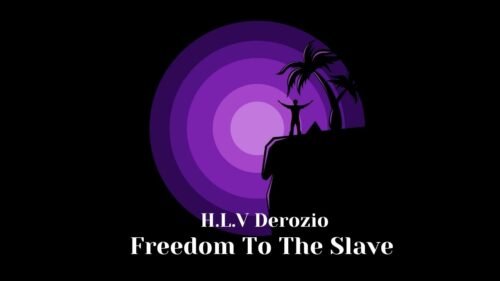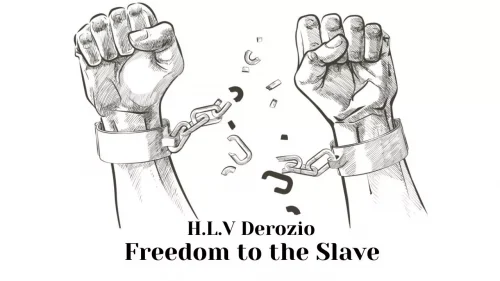The Joy of Liberation: Freedom to the Slave
Freedom To The Slave Summary
H.L.V. Derozio’s poem “Freedom To The Slave” (1827) is about a slave who regains his freedom after prolonged captivity. In the first stanza, the poet expresses the excitement of the newly liberated slave.
As the slave comes to know about his freedom, he feels jubilant. He feels the wind and looks at the birds and the stream. Shortly thereafter, he realizes that similar to those natural elements, he is also free.
In the second stanza, the speaker addresses freedom and says that it keeps igniting the altar of the soul. Patriot and brave men are ready to sacrifice their lives for liberty.
He also praises the benignant man who gives freedom to the slave for the sake of the slave’s freedom.
Freedom To The Slave Analysis
An epigraph
As the slave departs, the Man returns- Campbell
Campbell 13
In the beginning, the poet quotes an epigraph “And as the slave departs, the man returns” (Campbell 13).
He quotes the line from part I of Campbell’s long poem “The Pleasures of Hope”. It is about the loss of Warsaw and liberty in the fight for freedom. However, it hopes for betterment in society.
During the period of enslavement, the prisoner becomes a slave. He gets a slave identity.
However, as the period of slavery finishes, his identity as a slave dissolves.
Contrarily, the latent identity of the slave comes into existence. The freedom-loving man in him becomes alive.
The epigraph sets the context of the poem. Both the prisoner in Campbell’s poem and Derozio’s poem have been slaves for a long time. After an extended time, he gets freedom. Thus, he becomes elated on the cheerful occasion.

The State of Mind of the Slave
When someone informs the slave about the end of his slavery, his first reaction is notable. The slave’s heart beats in excitement when he realizes he is free from the shackles of bondage.
The poet uses anaphora in the first and third lines of the first stanza. He does that to emphasize the slave’s state of mind:
“How felt he when he first was told
Derozio
A slave he ceased to be
How proudly beat his heart, when first”.
The feeling of freedom rejuvenates him. As he discards his slave identity, his previous identity as a slave disappears and the man in him becomes alive again. The noble feelings of the soul such as honor, kindness, gratitude, joy, and love revive again.
He stands up and there is no need to kneel. In the state of slavery, a slave must bow down to the master. The physical posture of bowing down conveys the withdrawal of one’s ‘self’ to his master.
In the poem, as the slave gets freedom, he stands on his feet.
This act of standing on his hints getting back his independence. As the slave stands, his thoughts uplift. It means the mental elevation of the slave. The slave is no longer a slave.
The slave looks above and feels the fresh wind. He smiles jubilantly to see the flying wild birds and the running stream that is flowing beneath him. They represent freedom in nature.
Besides the winds and wild birds, there is another element of nature that complements his sense of freedom. That is the stream. The relentlessly flowing stream implies freedom.
A sense of relief and happiness in the slave brings tears to his eyes. He is content to feel that he is also free, like the winds, the wild birds, and the stream.
The poet uses imagery. We find imagery in the lines below:
“The breath of heaven
Derozio
Around him freshly blew;
He smiled exultingly to see
As the wild birds as they flew,
He looked upon the running stream”
He uses imagery to convey the slave’s emotional state of mind. Using simile in the line “I’m free as they!” explains the comparison between the inner and outer world.
Like the fresh winds, the slave also feels free. The slave is delighted to see the wild birds. Because he can also roam freely like those wild birds with no restriction.
A Eulogy to Freedom
In the second stanza, the poet eulogizes freedom. The poet shifts his focus from the slave to freedom with the change of stanza. The poet uses the literary device apostrophe and addresses freedom, “Oh freedom!”
In the eulogy, he says there is a specialty even in its name. It flares up the altar of the soul with endless flame. Its name is enough to keep igniting the essence of man, the soul.
Everyman has a close affinity with freedom. Man, by nature, wants to be free. Freedom vitalizes the soul. The patriot, and the brave heart will bear the pain for freedom.
The poet applauds the patriot and says, “Success attends the patriot sword.” Here, the poet personifies success and uses the literary device metonymy “patriot sword” to refer to the patriot. The patriot who is ready to surrender his life for freedom achieves success.
The speaker also praises the brave heart whose breast is injured and the gush of blood flows in the fight for freedom. The ‘breast’ is an example of synecdoche. ‘Breast’ is a part of the body that represents the man.
Similar to “The Orphan Girl”, the poet towards the end also praises the tender-hearted man who empathizes with the degraded condition of a slave.
The poet uses synecdoche ‘hand’ again to refer to the generous man.
Having seen the wretched condition of the slave, he shatters the chain of bondage and rescues him from the autocrat’s tyranny.

The tyrant and benevolent man have different attitudes toward the slave. The man who releases the slave is indeed free. Only a free man can liberate someone. A tyrant who imprisons someone is also a slave, along with the oppressed.
To explain, I would like to refer to Mandela’s view of freedom. Mandela, in his autobiography Long Walk to Freedom, says that an oppressor is not a free man because prejudice and narrow-mindedness blind him.
The tyrant is free on a surface level. But he is not free. Negative emotions like hatred confine him.
Such negative emotions blind him from realizing the truth that everyone is born to be free and everyone deserves it. Therefore, the tyrant snatches the slave’s freedom and keeps him in captivity.
Opposingly, the kind-hearted man understands the value of freedom. His mind is free from negative emotions. He understands how significant freedom is, not only for him but also for others.
In this context, Mandela says,
“For to be free is not merely to cast off one’s chains, but to live in a way that respects and enhances the freedom of others.”
Mandela, 115
This is aptly applied to the generous man’s attitude. The man who gives freedom to the slave respects the freedom that the imprisoned slave deserves. Therefore, he breaks the chains and sets the slave free.
The Theme of Freedom of the Slave
For the theme, watch the video below-
Conclusion
H. L. V Derozio wrote, “Freedom To The Slave” in 1827. It was the time when the Anti-slavery movement was prevalent in England. The anti-slavery movement or abolitionism was a movement to finish the long tradition of slavery in Western Europe and America in the late 18th and 19th centuries.
If we consider Derozio wrote the poem against the backdrop of the abolition movement, then we can say that the last lines of the poem imply Derozio’s support for the anti-slavery movement. Thanks to the people who stopped the barbaric tradition. The man who frees the slave should be blessed. The slave is free for that person.
Man’s existence depends on his freedom. Freedom gives meaning to man’s existence. Freedom adds meaning to the life of a freed slave.
Bibliography
- The Editors of Encyclopedia Britannica. “Abolitionism European and American social movement.” Britannica, 25 April 2020, https://www.britannica.com/biography/Thomas-Clarkson.
- Poems of H.L.V Derozio. 1827, pp. 11-12.
- Thomas Campbell. The Pleasure of Hope. 1858. The Perfect Library. Page 13.
- Nelson Mandela. The Long Walk to Freedom. Little Brown, 1994. https://zelalemkibret.files.wordpress.com/2012/01/the-autobiography-of-nelson-mandela.pdf
This page is really helpful
Thanks and regards 😌
Good to know that Tiasa 😊😊😊
Thank you so much for this helpful page
You’re welcome Rhiddhi😊😊😊
This page is very help full for us ,thank you so much
I can’t thank you enough. Thank you for taking the time to leave a comment like this 😊😊😊
Really helpful, thank you for this summary, Sir!
You are welcome, Sarah 😊😊😊
Tqq ❤️
You are welcome, Puja 😊😊😊
Helpful sir 😊💖
Glad to know that, Meraj 😊😊😊
Well done
Thanks
very helpful…thankyou so much 🙂
Thank you, Anamika, for the feedback! 😊😊😊
It helped a lot… Thank you sir 😇
Glad to hear that, Sohini🤗🤗🤗